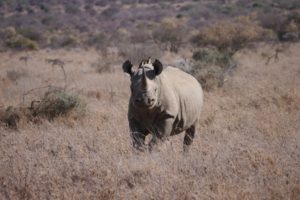Photo credit: International Rhino Foundation
The Sumatran rhino (Dicerorhinus sumatrensis) is the world’s oldest surviving rhino species but with an estimate of less than 100 left, their future is looking bleak. Conservation efforts, such as the breeding programme at the Sumatran Rhino Sanctuary (SRS) in Indonesia’s Way Kambas National Park, are crucial if the species is to survive. Earlier this week, this article on Mongabay.com gave us a useful overview of the Sumatran rhino’s situation and the efforts underway to save the species.
In 2012, a ray of hope was born at SRS, in the form of a baby male called Andatu. Andatu is particularly special being the first rhino born in the sanctuary and only the fourth born in captivity in the past 100 years. Sumatran rhinos have a unique breeding behaviour, which makes breeding in captivity difficult. A female Sumatran rhino is only receptive to mating during a single day of her oestrous cycle, which if successful results in a gestation period of 15-16 months. The calf then remains reliant on the mother for the first several years of its life, through which the mother is usually restricted from breeding with a male.
The Borneo Rhino Sanctuary houses another three Sumatran rhinos, but these are a subspecies (Dicerorhinus sumatrensis harrissoni) of which only a handful are believed to remain in the wild. So far this programme has been kept separate from the SRS due to their genetic differences. But more recently, the risk of integrating the programmes and losing a subspecies to save the whole species is being considered as a risk worth taking.
It is important to maintain focus on the wild Sumatran rhinos, the majority of which are found in three parks in Sumatra: Bukit Barisan Selatan, Gunung Leuser National Park and Way Kambas. Unfortunately none of these three populations are connected and each is split into smaller subpopulations that are less resilient to poaching effects. An ideal solution would be to create habitat corridors to connect the populations and encourage breeding. Conservationists believe this may not be possible due to high rates of deforestation caused by the palm oil and paper industry and increasing human populations and development. The alternative method would be the consolidation of these rhinos into two or three large populations, a method that has proven successful in other wild rhino species. To do this a more accurate population estimate is required, but this is made challenging by the rhinos’ elusive and shy natures as well as limited funding for the survey work required.
On the brighter side, there is evidence that Sumatran rhinos are still breeding in the wild, and a decision has been made to employ more rangers to increase protection against poaching. Conservation is always a slow process, but with continued support for this unique rhino species it may be possible to prevent it from disappearing forever.
Save the Rhino International is helping to support efforts to save the last Sumatran rhinos by funding Rhino Protection Units in Sumatra, as well as the Sumatran Rhino Sanctuary. You can donate specifically to these projects here.







